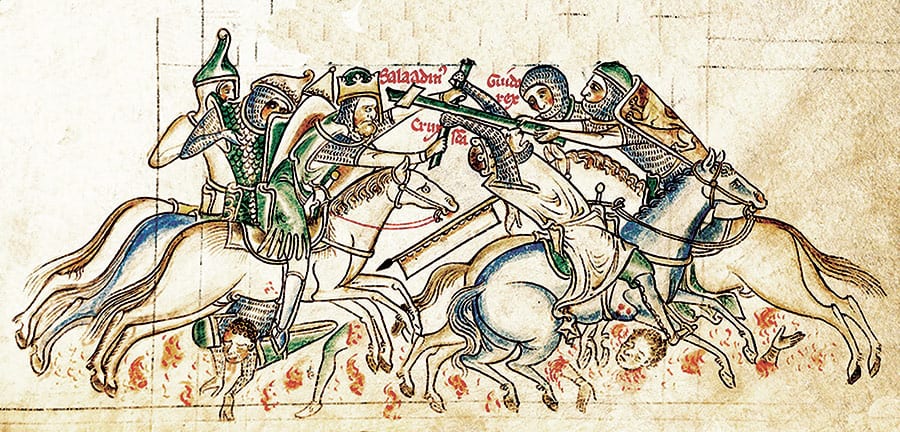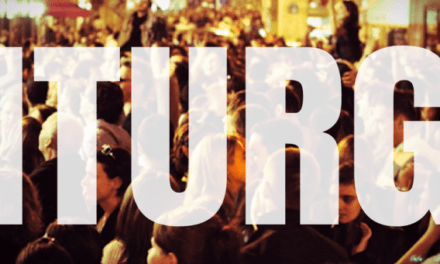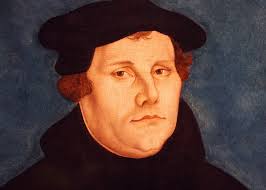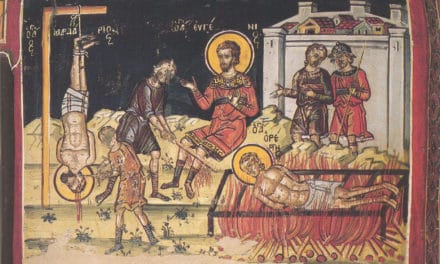Episode 55 – The Crusades, Part 2
As Bruce Shelly aptly states in in his excellent book Church History in Plain Language, for the past 700 years Christians have tried to forget the Crusades, though neither Jews nor Muslims will let them. Modern Christians want to dismiss that era of Church History as the insane bigotry of the illiterate and superstitious. But to do so is to show our own kind of bigotry, one neglectful of the historical context of the European Middle Ages.
The Crusaders were human beings, who like us, had mixed motives often in conflict. The word crusade means to “take up the cross,” hopefully after the example of Christ. That’s why on the way to the Holy Land crusaders wore the cross on their chest. On their return home they wore it on their back. [1]
In rallying the European nobility to join the First Crusade, Pope Urban II promised them forgiveness of past sins. Most of them held a deep reverence for the land Jesus had walked. That devotion was captured later by Shakespeare when he has King Henry IV say:
We are impressed and engag’d to fight …
To chase those pagans in those holy fields,
Over whose acres walked those blessed feet,
Which fourteen hundred years ago were nail’d,
For our advantage on the bitter cross.
For Urban and later popes, the Crusades were a Holy War. Augustine, whose theology shaped the Medieval Church, laid down the principles of a “just war.” He said that it must be conducted by the State; its broad purpose was to uphold an endangered justice, which meant more narrowly that it must be defensive to protect life and property. In conducting such a just war there must be respect for noncombatants, hostages, and prisoners. And while all this may have been in the mind of Pope Urban and other church leaders when they called the First Crusade, those ideals didn’t make it past the boundary of Europe. Once the Crusaders arrived in the East, the difficulties of their passage conspired to justify in their minds the wholesale pillaging of the innocent. Even those who’d originally taken up the Crusader cross with noble intent, didn’t want to be left out of acquiring treasure once the looting began. After all, everyone else is doing it?
As we return to our narrative of the First Crusade, let’s recap …
What triggered the Crusade was a request for assistance from Byzantine emperor Alexios I Komnenos. Alexios worried about the advances of the Muslim Seljuk Turks, who’d reached as far west as Nicaea, a suburb of Constantinople. In March 1095, Alexios sent envoys to the Council of Piacenza to ask Pope Urban II for aid against the Turks. Urban’s reply was positive. It’s likely he hoped to heal the Great Schism of 40 yrs before that had sundered Western and Eastern churches.
In the Summer of 1095, Urban turned to his homeland of France to recruit for the campaign. His journey ended at the Council of Clermont in November, where he gave an impassioned sermon to a large audience of French nobles and clergy, detailing the atrocities committed against pilgrims and Christians living in the East by the Muslims.
Malcolm Gladwell wrote a bestseller in 2000 called The Tipping Point. The Pope’s speech was one of those, an epic tipping point that sent history in a new direction. Urban understood what he proposed as an act so expensive, long, and arduous that it amounted to a form of penance capable of discharging all sins for those who went crusading. And he understood how his audience’s minds worked. Coming from a noble house himself and having worked his way up through the ranks of the monastery and Church, he understood the puzzle that lay at the heart of popular religious sentiment. People were keenly aware of their sinfulness and sought to expunge it by embarking on a pilgrimage, or if that wasn’t possible, to endow a monk or nun so they could live a life of sequestered holiness on their behalf. But their unavoidable immersion in the world meant it was impossible to perform all of the time-consuming penances which could keep pace with their ever-increasing catalog of sin. Urban saw that he could cut the Gordian knot by prescribing a Crusade. Here at last was a way for men given to violence, one of the most grievous of their misdeeds, to USE it as an act of penance. Overnight, those who were the most in need of penance became the very ones most likely to be the cause of the Crusade’s success.
While there are different versions of Urban’s sermon, they all name the same basic elements. The Pope talked about the need to end the violence the European knights continued among themselves, the need to help the Eastern Christians in their contest with Islam, and making the pathways of pilgrims to Jerusalem safe again. He proposed to do this by waging a new kind of war, an armed pilgrimage that would lead to great spiritual and earthly rewards, in which sins would be remitted and anyone who died in the contest would bypass purgatory and enter immediately into heaven’s bliss.
The Pope’s speech at Clermont didn’t specifically mention liberating Jerusalem; the goal at first was just to help Constantinople and clear the roads to Jerusalem. But Urban’s later message as he travelled thru Europe raising support for the Crusade, did include the idea of liberating the Holy City.
While Urban’s speech seemed impromptu, it was in fact well-planned. He’d discussed launching a crusade with two of southern France’s most important leaders who gave enthusiastic support. One of them was at Clermont, the first to take up the cause. During what was left of 1095 and into 96, Pope Urban spread the message throughout France and urged the clergy to preach in their own regions and churches throughout Europe.
Despite this planning, the response to call for the Crusade was a surprise. Instead of urging people to JOIN the campaign, bishops had to dissuade certain people from joining. Women, monks, and the infirm were forbidden, though many protested their exclusion. Some did more than protest; the defied officials and made plans to go anyway. When Pope Urban originally conceived the crusade, he envisioned the knights and nobility leading out trained armies. It was a surprise when thousands of peasants took up the cause.
What was the bishop to say to these peasants when they indicated their intent to go? “You can’t. You have to stay and tend your fields and herds.” When the peasants asked why, the bishops had no good answer, so they formed companies and set off. The clergy was forced to give grudging permission. They gathered local groups of peasants and had them take a vow of devotion to the Holy Cause, setting as their destination, the Church of the Holy Sepulcher in Jerusalem.
Alongside the enthusiasm of the peasants, Urban courted the nobility of Europe, especially in France, to lead the Crusade. Knights from both northern and southern France, Flanders, Germany, and Italy were divided into four armies. Sadly, they often saw themselves in competition with each other rather than united in a common cause. They vied for prominence in bringing glory to God; oh, and of course, the loot that went along with it.
While it was the scion of the noble houses that led a few of the armies, the bulk of the knights were lesser sons of the nobility whose only route to wealth lay in conquest. The eldest brother was set to inherit the family name and estate. So hundreds of these younger sons saw the Crusades as a way to make a name for themselves and carve out their own domain in newly acquired lands. If they didn’t return to Europe laden with treasure, they hoped to settle down on land they’d won with the sword.
One of the many sad results of the spin-up for the First Crusade was the persecution of Jews in Northern France and the Rhineland. Anti-Semitism bubbled beneath the surface of this region for generations. It spilled over now as peasants and commoners mobilized to remove the infidels form the Holy Land. Some began to question why a trip to the Middle East was needed when there were Christ-haters living right at hand. So Jews were attacked, their homes burned, businesses sacked.
As we saw in our last episode, the peasants formed into bands and rampaged their way across Europe to Constantinople. They lacked the discipline and supplies of the knights so they foraged their way East like Sherman on his march to the Sea during the American Civil war. Though we don’t know the numbers, thousands of these peasant crusaders were killed along the way as armed defenders came out to oppose their trek across their lands.
When they finally arrived in Constantinople, they were hurriedly escorted across the Bosporus in August of 1096. At that point they split into two groups. One tried to recapture Nicaea but failed when the Turks surrounded and wiped them out. The other group was ambushed and massacred in October.
This phase of the First Crusade is called The People’s Crusade because it was made up of btwn 20 and 30,000 commoners. Its leadership include some minor nobles but its most visible leader was the odd Peter the Hermit.
Peter’s leadership of The People’s Crusade was due to his fiery recruitment sermons. He wasn’t so skilled in the tactical management of 30,000 would-be warriors. Once they arrived in Constantinople, his lack of administrative skill became obvious and the handful of knights who’d joined up realized they need to take control. But they refused to submit to one another and fragmented into different groups based on nationality. This lack of leadership proved fatal. They lost control of their so-called army which set to looting the homes and towns of Eastern Christians. The German contingent managed to seize a Seljuk city and the French began agitating for their leaders to do likewise. A couple Turkish spies spread a rumor in the French camp that the Germans were marching on Nicaea. So the French rushed out to beat them to it. While passing thru a narrow valley, they were wiped out by waiting Seljuk forces.
A remnant made it back to Constantinople where they joined up with the knights who were just then, at the end of the Summer, arriving from Europe. This force formed into contingents grouped around the great lords. This was the kind of military force Pope Urban II and the Emperor Alexius had envisioned.
The Crusaders realized they had to conquer and occupy Antioch in Syria first or a victory over Jerusalem would be short-lived. They took the city, but then barely survived a siege laid in by the Turks. Breaking the siege in the Spring of 1099, the leaders of the Crusade ended their quarrels and marched South. Their route took them along the coast to Caesarea, where they headed inland toward their goal. They arrived in the vicinity of Jerusalem in early June.
By that time the army was reduced to 20,000. The effect of seeing the Holy City for the first time was electrifying. These men had fought and slogged their way across thousands of miles, leaving their homes and cultures to encounter new sights, sounds and tastes. And every step of the way, their goal was Jerusalem—the place where Jesus had lived and died. Accounts of that moment say the warriors fell on their knees and kissed the sacred earth. They removed their armor and in bare feet w/tears, cried out to God in confession and praise.
A desperate but futile attack was made on the City five days later. Boiling pitch and oil were used by Jerusalem’s defenders, with showers of stones and anything else they could get their hands on that would do damage. Then the Crusaders set a siege that took the usual course. Ladders, scaling towers, and other siege-engines were built. The problem is, they had to travel miles to get wood. The trees around Jerusalem had all been cut down by the Roman General Titus twelve centuries before. They’d never grown back.
The City was surrounded on 3 sides by Raymund of Toulouse, Godfrey, Tancred, and Robert of Normandy. It was a hot Summer and the suffering of the besiegers was intense as water was scarce. Soon, the valleys and hills around the city walls were covered w/dead horses, whose rotting carcasses made life in camp unbearable.
Someone got the brilliant idea to duplicate Joshua’s battle plan at Jericho. So the Crusaders took off their shoes and with priests leading, began marching around Jerusalem, hoping the walls would fall down. Of course, they didn’t. I wonder what they did with the guy who came up with the idea. Help at last came with the arrival of a fleet at Joppa harbor from Genoa carrying workmen and supplies who went to work building new siege gear.
The day of the final assault finally arrived. A huge tower topped by a golden cross was dragged up to the walls and a massive plank bridge was dropped so the Crusaders could rush from tower to the top of the wall. The weakened defenders couldn’t stop the mass of warriors who flooded into their City.
The carnage that followed is one more chapter in the many such scenes Jerusalem has known.
Once they’d secured the City, the blood-splattered Crusaders paused to throw God a bone. Led by Godfrey, freshly changed into a suit of white linen, the Crusaders went to the church of the Holy Sepulcher and offered prayers and thanksgiving. Then, devotions over, the massacre recommenced. Neither the tears of women, nor the cries of children, did anything to halt to terror. The leaders tried to restrain their troops but they’d been let off the chain and were determined to let as much blood out of bodies as possible.
When it was finally over, Muslim prisoners were forced to clear the streets of the bodies and blood to save the city from pestilence.
Remember Peter the Hermit, who’d lead the peasant army to disaster? He made it to Jerusalem before returning to Europe where he founded a monastery and died in 1115.
Pope Urban II also died just 2 weeks after the fall of Jerusalem, before the news reached him.
Looking back, it’s clear the First Crusade came at probably the only time it could have been successful. The Seljuk Turks had broken up into rival factions in 1092. The Crusaders entered into the region like a knife before a new era of Muslim union and conquest opened. That’s what those newly arrived Crusaders would now have to face.
Just eight days after capturing Jerusalem, a permanent government was set-up. It was called “The Kingdom of Jerusalem.” Godfrey was elected king, but declined the title of royalty, unwilling to wear a crown of gold where the Savior had worn a crown of thorns. He adopted the title Baron and Defender of the Holy Sepulcher.
From the moment of its birth, the Kingdom of Jerusalem was in trouble. Less than a year later they made an appeal to the Germans for reinforcements. And Godfrey survived the capture of Jerusalem by only a year. He was buried in the Church of the Holy Sepulcher, where his sword and spurs are still on display. On his tomb is the inscription: “Here lies Godfrey of Bouillon, who conquered all this territory for the Christian religion. May his soul be at rest with Christ.”
Rome immediately moved to make The Kingdom of Jerusalem part of it’s region of hegemony. The archbishop of Pisa, Dagobert, who’d been a part of the Crusade, was elected to be Jerusalem’s Patriarch.
The new rulers turned from conquest to defense and governing. They tried to layer the feudal system of Europe onto Middle Eastern society. The conquered territory was distributed among Crusader barons, who held their possessions under the king of Jerusalem as overlord. The four chief fiefs were Jaffa, Galilee, Sidon, and east of the Jordan River, a region called Kerat. The counts of Tripoli and Edessa and the prince of Antioch were independent of Jerusalem but were closely allied due to the nearby Muslim menace.
The Crusader occupation of Israel was far from peaceful. The kingdom was torn by constant intrigues of civil rulers and religious clerics. All that while it faced unending threats from without. But it was the inner strife that was the main cause of weakness. Monks settled in swarms all over the country. The Franciscans became guardians of the holy places. The offspring of the Crusaders by Moslem women, called pullani, became a blight as they were given over to unrelenting greed and the most grotesque immorality.
When Godfrey died, he was succeeded by his brother Baldwin, count of Edessa. Baldwin was intelligent and the most active king of Jerusalem. He died after eight years; his body laid next to his brother’s.
During Baldwin’s reign, the kingdom grew significantly. Caesarea fell to the Crusaders in 1101, then Ptolemais in 1104. Beirut in 1110. But Damascus never fell to the Crusaders. With the progress of their arms, they built castles all over their holdings in the Middle East. The ruins of those fortifications stand today and are premier tourist sites.
Many of the Crusaders, who began the adventure planning to return to Europe, decided rather to stay once the work of conquest was finished. One wrote, “We who were Westerners, are now Easterners. We have forgotten our native land.” Other Crusaders did return to Europe, only to return later. Even several European kings spent long stays in the Holy Land.
During Baldwin’s reign most of the leaders of the First Crusade either died or went home. But their ranks were continually replenished by fresh expeditions from Europe. Pope Pascal II, successor to Urban II, sent out a call for recruits. The Italian cities furnished fleets, and coordinated with land forces. The Venetians, Pisans, and Genoese established quarters of their own in Jerusalem, Acre, and other cities. Thousands took up the Crusader cause in Lombardy, France, and Germany. They were led by Anselm, archbishop of Milan, Stephen, duke of Burgundy, William, duke of Aquitaine, Ida of Austria, and others. Hugh who’d gone home, returned. Bohemund also came back with 34,000. Two Crusader armies attacked the Islamic stronghold at Bagdad.
Baldwin’s nephew, also named Baldwin, succeeded his uncle and reigned for 13 years, till 1131. He conquered the strategic city of Tyre on the coast. It was 1124 and that marked the high-water point of Crusader power.
Over the next 60 yrs, Jerusalem saw a succession of weak rulers while the Muslims from Damascus to Egypt were uniting under a new band of competent and charismatic leaders. The last of these was Saladin. He became caliph in 1174 and set out to retake Jerusalem.
But that’s for our next episode . . .
[1] Shelley, B. L. (1995). Church history in plain language (Updated 2nd ed.) (187–188). Dallas, Tex.: Word Pub.






The Franciscans did not get control of the holy land shrines until 1272 and was granted that by the Egyptian sultan baibars.The reference to them receiving control after the first crusade at 17 minutes 28 seconds seems to imply this st Francis who the order was named after was not born until 1181. for more on this moment in history check out the wikipedia link below.
http://en.wikipedia.org/wiki/Custodian_of_the_Holy_Land
PH,
That entire paragraph was a reference to the larger Crusader Era in the Holy Land. The Franciscans, did eventually take a custodial role over many of the holy sites, and yes that was later, but that entire paragraph referred to the larger context of the Crusader occupation of the Middle East, as I thought the reference to the pullani made clear.
Sorry if it wasn’t.
Lance